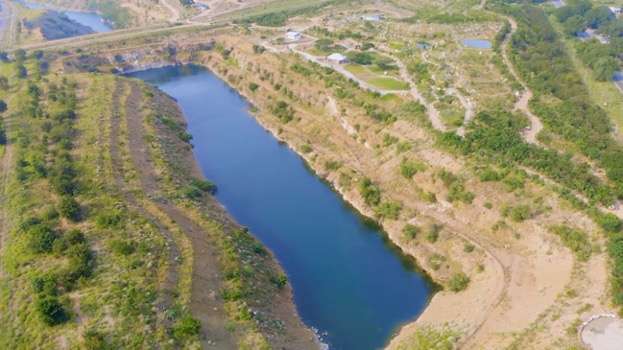The afforestation of the exhausted limestone mines in Pandalgudi began in earnest in Dec 2018, after an initial site visit in August of the same year. Previous to this, over the previous 2 years, various pilot projects had been undertaken to assess the use of native species for this kind of work.The area of Pandalgudi is situated in a rain fall deficient area, as it falls in the rain shadow of the western ghats during the SW monsoon and of Sri Lanka in the NE monsoon. Annual rainfall is less than 500 mm, and the rainfall pattern is highly variable, with prolonged periods of drought, coupled with high summer temperatures, commonly above 40 degrees Celsius. The soil of the area is generally black cotton clay, with an underlying bed rock at varying depths. The water table has a high TDS value, around 2000 ppt, due to the presence of subsurface canker.
The mining areas are belonging to Ramco Cements, and had been mined during from the 1980’s for a period over 30 years. The limestone is found in a vertical seam, 10 – 18 meters wide, and is extracted by excavation of perpendicular benches, to a depth of around 60 meters. Consequently, the final width of the mined areas are around 130 meters wide. The superfluous excavated rocks are piled around the open mine and at the end of operations are generally backfilled as much as possible.
This work began in 2019 on 65 acres, but over the past 3 years has extend out to 350 acres, which will eventually over the next 5 to 10 years to over 850 acres. The plantation patterns are evolving over time as each successive year’s planting adds to our knowledge, and the availability of native species increases due to the development of an on-site nursery. Initially a number of non-native Nitrogen fixing species were included in the planting mix, however these have now been replaced with native species such as Acacia leucophloea, Acacia chundra, Albizia amara, Albizia lathamii, Pterocarpus santalinus and Hardwickia binata. Overall, we are now using over 75 native species of trees and shrubs in the plantations.
The eco type for this area is the southern thorn forest, and in the 2022 planting season there will be one area set aside for plantation exclusively with representatives of this forest type. Planting conditions in this area are severe due to the intense summer conditions and also due to the planting areas generally being on excavated rock piles. Pitting is carried out by mechanical means, and the holes are filled with black cotton soil that was removed from site prior to the mining activities. This soil is augmented with 1.5 kg of vermicompost at the time of planting, and again with 1kg when the rainy season returns. Plants are watered on average once a week for the first two years of establishment.
The results have been extremely rewarding with some species growing over one meter per year for the first three years. This is no doubt due in some part to the high level of aftercare, but is also thought to be a result of the loose nature of the soil allowing extensive root exploration.











